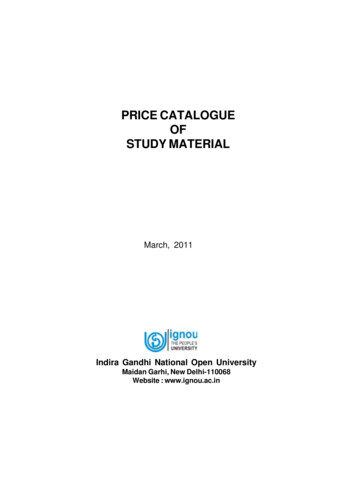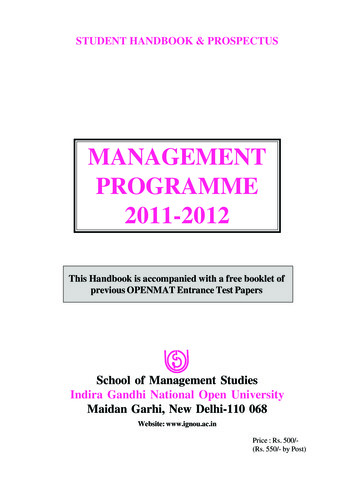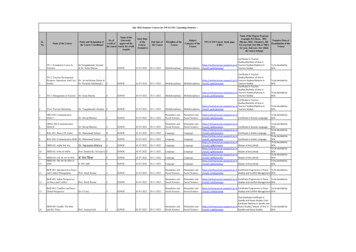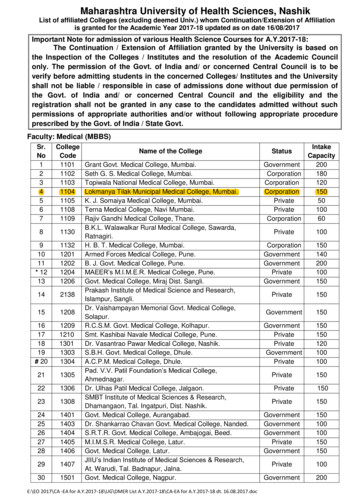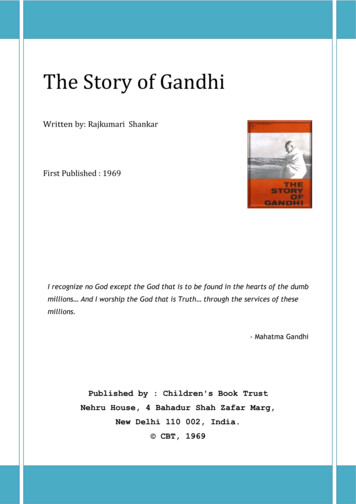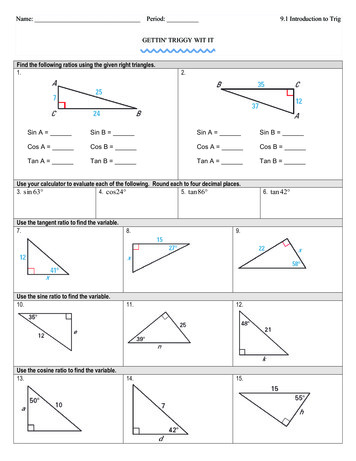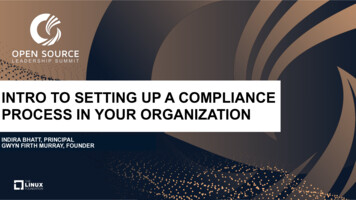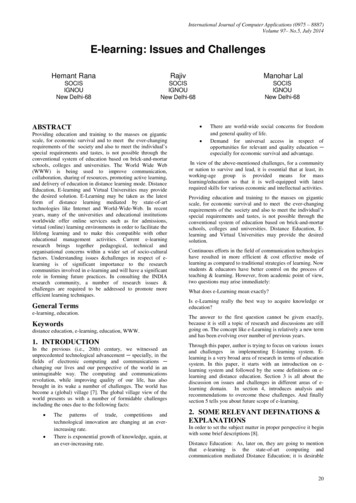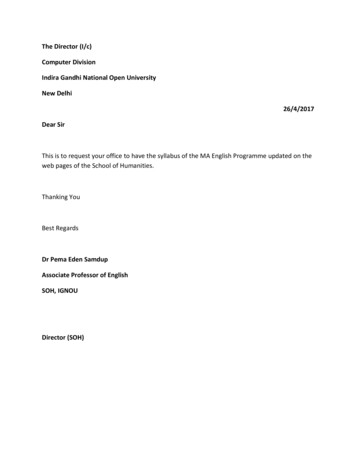
Transcription
The Director (I/c)Computer DivisionIndira Gandhi National Open UniversityNew Delhi26/4/2017Dear SirThis is to request your office to have the syllabus of the MA English Programme updated on theweb pages of the School of Humanities.Thanking YouBest RegardsDr Pema Eden SamdupAssociate Professor of EnglishSOH, IGNOUDirector (SOH)
MA ENGLISH SYLLABUSMEG 01: BRITISH POETRYBlock I: Orientations for the Study of Poetry & the Medieval Poet ChaucerUnit 1: From the Evaluation of Portraits towards the Explication of Poems (1370 – 80)Unit 2: A Prelude to the Study of Poetry (Rhetoric & Prosody), Iambic, Trochaic, Anapest, Dactylic,Amphibrachic, Strong stress metres, quantitative metres, syllabis metres, rhythm, rhymeschemes, etcUnit 3: The Age of ChaucerUnit 4: Chaucer’s Poetry: A General Survey : Roman de la Rose, The Book of the Duchess, The House ofFame, Parliament of Fowls, Prologue to the Legend of Good Women, The Nun’s Priest’s Tale,Troilus and Criseyde, The Canterbury Tales,Unit 5: The General Prologue to The Canterbury TalesUnit 6: ‘A Study of the Nonne Preestes Tale’ IUnit 7: ‘A Study of the Nonne Preestes Tale’ IIBlock 2: Renaissance Poets: Undertaking a Study of SpenserUnit 8: The Renaissance AgeUnit9: Edmund SpenserUnit 10: Spenser’s Poetry: The Amoretti Sonnets, Sonnet 34, Sonnet 67, Sonnet 77Unit 11: Spenser’s Poetry – II: The Epithalamion, The Prothalamion,Block 3: The Metaphysical Poets: Donne, Herbert & MarvellUnit 12: British Poetry in the 17th Century (pre-Restoration): Historical Background, Cultural Background,The Astronomical Revolution, Spenserians (– Phineas Fletcher, Giles Fletcher, Wither, WilliamBrowne), the Cavalier Poets (- Robbert Herrick, Thomas Carew, Sir John Suckling, RichardLovelace), the Metaphysical Poets (- Henry Vaughan, Richard Crashaw, Thomas Traherne), theEarly Augustans (- Edmund Waller, Sir William Davenant, Sir John Denham, Abraham Cowley)Unit 13: John Donne: Portrait of the Man, His Thematic and Technical Innovations and Textual Study offour Love Poems; The Flea, Twicknam Garden, The Good Morrow, The ExtasieUnit 1 4: John Donne: Further Explorations into Poems of Love and Faith: The Canonization, AValediction: Forbidding Mourning, A Nocturnal Upon S Lucies Day, Batter My Heart, ThreePerson’d God, Hymn To God The FatherUnit 15: George Herbert: A Study of His Poems: Affliction, The Collar, Easter Wings, Love (3), The Pulley,Redemption, The Windows, AaronUnit 16: Andrew Marvell: A Study of His Poems: To His Coy Mistress, The Garden, An Horation Ode UponCromwell’s Return From IrelandBlock 4: Renaissance Poets: Studying MiltonUnit 17: The Late RenaissanceUnit 18: Milton: The LifeUnit 19: A Survey of Milton’s Lesser Poems & Prose: On the Death of An Infant, At A Vacation ExerciseUnit 20: On The Morning of Christ’s Nativity & Lycidas
Unit 21: L’Allegro, Il Penseroso &the Sonnets 19 & 23Block 5: The Neoclassical Poets: Dryden & PopeUnit 22: The Age of DrydenUnit 23: John DrydenUnit 24: Mac Flecknoe, (Alexander’s Feast Or The Power of Music An Ode In Honour of St Cecilia’s Day)Unit 25: Pope: A Background to An Epistle to Dr ArbuthnotUnit 26: Pope: The Study of An Epistle to Dr ArbuthnotBlock 6: The Romantic Poets: Blake, Wordsworth & ColeridgeUnit 27: Introduction to Romantic Poetry: Early Romantic Poets (- James Thomson, Mark Akenside,Joseph Warton, William Collins, Thomas Gray, William Cowper, Robert Burns, Blake, Wordsworth,Coleridge, Byron, Shelley & Keats)Unit 28: William Blake: Songs of Innocence & Songs of Experience, The Lamb, The Chimney Sweeper,The Divine Image, The Sick Rose, London, The Tyger,Unit 29: Wordsworth’s The Prelude, Book I: A Critical AnalysisUnit 30: Coleridge: Kubla Khan & Dejection: An OdeBlock 7: The Second Generation Romantic Poets: Shelley & KeatsUnit 31: The Volcanic Voice of Hope: P B ShelleyUnit 32: A Study of The Triumph of LifeUnit 38: Keats: Hyperion: A Fragment, IUnit 34: Keats: Hyperion: A Fragment, IIUnit 35: The Romantic Age: A ReviewBlock 8: The Victorian Poets: Robert Browning, D G & Christina Georgiana Rossetti, Oscar WildeUnit 36: The Victorian Age: Selected StudiesUnit 37: Robert Browning: Life & Aspirations: Sordello in MantuaUnit 38: Robert Browning: Two Early Poems: Porphyria’s Lover, The Bishop Orders His Tomb at StPraxed’s ChurchUnit 39: Two Poems from Men and Women: Childe Roland To The Dark Tower Came, Fra Lippo LippiUnit 40: The Pre- Raphaelite Brotherhood: Dante Gabriel Rossetti & Christina Georgina Rossetti: MySister’s Sleep, The Blessed Damozel; Goblin MarketUnit 41: Oscar Wilde: The Ballad of Reading GaolBlock 9: The Modernist PoetsUnit 42: Modern British Poetry: An IntroductionUnit 43: W B Yeats: Background, System, and Poetic Career until 1910: Adam’s Curse, No Second TroyUnit 44: The Later Poetry of W B Yeats: Easter 1916, Sailing To Byzantium, Lapis LazuliUnit 45: T S Eliot: The Waste Land (I)Unit 46: T S Eliot: The Waste Land (II)Unit 47: T S Eliot: The Waste Land (III)Block 10: The Modernist & Post Modernist Poets: Dylan Thomas, Philip Larkin, Sylvia Plath, ASymposium & Essays and Evaluations
Unit 48: Dylan Thomas: And Death Shall Have No Dominion, Poem in October, Fern Hill, A Refusal toMourn the Death by Fire, Of Child in LondonUnit 49: Philip Larkin: I Remember, I Remember, Toads, Toads Revisited, Mr Bleaney, Church Going, TheWhitsun Weddings, At GrassUnit 50: Sylvia Plath & Confessional Poetry: The Colossus, Daddy, Lasy Lazrun, Purdah, Ariel, Pursuit, TheApplicant, Fever 103 Unit 51: So! Now! What is Poetry? Once Again: A SymposiumUnit 52: Essays & EvaluationsMEG 02: BRITISH DRAMABlock I: Marlowe: Doctor FaustusBlock II: Shakespeare: A Midsummer Night’s DreamBlock III: Shakespeare: HamletBlock IV: Ben Jonson: The AlchemistBlock V: John Millington Synge: The Playboy of the Western WorldBlock VI: George Bernard Shaw: PygmalionBlock VII: T S Eliot: Murder in the CathedralBlock VIII: John Osborne: Look Back in AngerBlock IX: Samuel Beckett: Waiting for GodotMEG 03: BRITISH NOVELBlock I: Henry Fieldings: The History of Tom Jones A Foundling (1749)Block II: Jane Austen: Pride and Prejudice (1813)Block III: Emily Bronte: Wuthering Heights (1847)Block IV: Charles Dickens: Great Expectations (1860 -1861, 1861, 1862)Block V: George Eliot: Middlemarch (1871)Block VI: Josef Conrad: Heart of Darkness (1898 -1899)Block VII: James Joyce: A Portrait of the Artist As A Young Man (1916)Block VIII: Edward Morgan Forster: A Passage to India (1912-14)MEG 04: ASPECTS OF LANGUAGEBlock I: What is Language?Block II: A History of the English LanguageBlock III: Phonetics & Phonology IBlock IV: Phonetics & Phonology IIBlock V: English SyntaxBlock VI: Language In Use - IBlock VII: Language In Use - IIBlock VIII: The Spread of EnglishBlock IX: StylisticsMEG 05: LITERARY THEORY & CRITICISMBlock I: An IntroductionBlock II: Classical Criticism
Block III: Romantic CriticismBlock IV: New CriticismBlock V: Marxist View of LiteratureBlock VI: Feminists TheoriesBlock VII: DeconstructionBlock VIII: Contemporary Literary TheoryMEG 06: AMERICAN LITERATUREBlock I: Contexts of American Literature: The Puritans & the EnlightenmentBlock II: American Fiction - IBlock III: American Fiction - IIBlock IV: American ProseBlock V: American Poetry - IBlock VI: American Poetry - IIBlock VII: American Short StoryBlock VIII: American DramaBlock IX: Toni Morrison: The Bluest EyeMEG 07: INDIAN WRITING IN ENGLISHBlock I: Non- Fictional ProseBlock II: Mulk Raj Anand: UntouchableBlock III: Raja Rao: KanthapuraBlock IV: Anita Desai: Clear Light of DayBlock V: Salman Rushdie: Midnight’s ChildrenBlock VI: The Short StoryBlock VII: PoetryBlock VIII: Mahesh Dattani: TaraMEG 08: NEW LITERATURES IN ENGLISHBlock 1: IntroductionBlock 2: A Grain of Wheat: Ngugi Wa Thiong’oBlock 3: A Dance of the Forests: Wole SoyinkaBlock 4: Ice- Candy – Man: Bapsi SidhwaBlock 5: A House for Mr Biswas: V S NaipaulBlock 6: Caribbean Poetry: Derek Walcott & Edward BrathwaiteBlock 7: The Solid Mandala: Patrick WhiteBlock 8: The Stone Angel: Margaret LaurenceMEG 09: AUSTRALIAN LITERATUREBlock 1: An Introduction to Australian LiteratureUnit 1: Australian LiteratureUnit 2: Australia – Land and HistoryUnit 3: Australia – People and CultureUnit 4: Literary Beginnings – Oral LiteratureUnit 5: Early LiteratureUnit 6: Themes and Trends
Block 2: Nineteenth Century Australian PoetryUnit 1: 19th Century Australian Poetry: An IntroductionUnit 2: W C Wentworth: Australasia, Wild Colonial BoyUnit 3: Charles Harpur: The Bush Fire, A Mid- Summer Noon in the Australian ForestUnit 4: Henry Kendall: Bell – Birds, After Many YearsUnit 5: A L Gordon & A B Paterson: The Sick Stockrider; The Man From Snowy RiverUnit 6: Ada Cambridge: An AnswerBlock 3: Introduction to Short FictionUnit 1: Introduction to short fiction /storyUnit 2: Marcus Clarke: The Seizure of the CyprusUnit 3: Barbara Baynton: The Chosen VesselUnit 4: Henry Lawson: The Drover’s Wife; The Union Buries It’s DeadUnit 5: Arthur Hoey Davis: Cranky JackUnit 6: Christina Stead: The Old SchoolBlock 4: Modern Australian Poetry (1901 -1970)Unit 1: Introduction: An OverviewUnit 2: Beginnings: Christopher Brennan – Each Day I See the Long Ships Coming Into Port; John ShawNeilson – The Orange TreeUnit 3: The Notion of Australia: Kenneth Slessor – South Country; R D Fitzgerald – This Night’s OrbitUnit 4: Keepers of the Flame: Judith Wright: Legend, Bullocky; David Campbell - The Australian Dream;Unit 5: Coming of Age: James McAuley - Terra Australis; A D Hope – Australia, Moschus Moschiferus;Unit 6: The Marginalised Voice: Rosemary Dobson – Cock Crow; Oodgeroo Noonuccal – We Are Going;Rex Ingamells – History, Moorawathimeering; ‘Ern Malley’ – Durer: Innsbruck, 1495; AniaWalwicz – Australia (prose); John Farrell – From Australia; Douglas Stewart –Terra Australis;Bernard O’ Dowd- Australia, The Southern CallBlock 5: Voss: Patrick WhiteUnit 1: Rise and Development of the Australian NovelUnit 2: As We First Read VossUnit 3: Romantic Elements in VossUnit 4: Multiple Themes in VossUnit 5: Modern Readings: Some Important AreasBlock 6: Contemporary Australian Poetry (1970 Onwards)Unit 1: Contemporary AustraliaUnit 2: Bruce Dawe & Les Murray: At Shagger’s Funeral; The Quality of Sprawl, BloodUnit 3: Chris Wallace- Crabbe & Gwen Harwood: Melbourne; In The ParkUnit 4: Ee Tiang & Kevin Gilbert: Coming To; Mister ManUnit 5: Mudrooroo Narogin & Gig Ryan: Harijan; If I Had A GunBlock 7: Remembering Babylon: David MaloufUnit 1: Contemporary Australian Fiction: An OverviewUnit 2: The Author, His Creativity and Remembering BabylonUnit 3: Structure, Characters and MetaphorsUnit 4: Narrative Strategies and CommunicationUnit 5: Themes
Block 8: The Removalists: David WilliamsonUnit 1: An Overview of Austalian DramaUnit 2: David Williamson’s Dramatic WorldUnit 3: Reading The RemovalistsUnit 4: Themes and TechniquesMEG 08: NEW LITERATURES IN ENGLISHBlock 1: IntroductionUnit 1: Naming the DisciplineUnit 2: African Literature: Culture and Post – Nationalist Politics in Kenya and NigeriaUnit 3: Caribbean Literature: The Aesthetics of DiasporaUnit 4: South Asian LiteratureUnit 5: Australian Literature: Interrogating National MythsUnit 6: Canadian Literature: Scanning the Literary LandscapeBlock 2: A Grain of Wheat: Ngugi Wa Thiong’oUnit 1: Africa – The Dark Continent and Kenya – The Land of Gikuyu and MumbiUnit 2: Literature and PoliticsUnit 3: Modern Novel in AfricaUnit 4: A Grain of Wheat - SummaryUnit 5: A Grain of Wheat – An EvaluationBlock 3: A Dance of the Forests: Wole SoyinkaUnit 1: An Introduction to Nigeria and to the Yoruba WorldUnit 2: Wole Soyinka’s Life and WorksUnit 3: A Dance of the Forests: SummaryUnit 4: Critical Commentary on A Dance of the ForestsUnit 5: Wole Soyinka’s Major Dramatic WorksBlock 4: Ice- Candy – Man: Bapsi SidhwaUnit 1: The Author: Background, Works, and Significance of the TitleUnit 2: The Narrative Voice in Ice- Candy- ManUnit 3: Feminist Inscriptions in Ice- Candy- ManUnit 4: Parsi Identity in Ice- Candy- ManUnit 5: Ice- Candy- Man as a Novel of the PartitionUnit 6: Bapsi Sidhwa’s Ice- Candy- Man: A Postcolonial PerspectiveBlock 5: A House for Mr Biswas: V S NaipaulUnit 1: Naipaul and his criticsUnit 2: Mr Biswas and the TulsisUnit 3: Mr Biswas and his Dream HouseUnit 4: Why did Mr Biswas want a House?Unit 5: Putting A House for Mr Biswas in PerspectiveBlock 6: Caribbean Poetry: Derek Walcott & Edward BrathwaiteUnit 1: Introduction to Caribbean Poetry
Unit 2: Derek Walcott - IUnit 3: Derek Walcott - IIUnit 4: (Edward) Kamau Braithwaite - IUnit 5: (Edward) Kamau Braithwaite - IIUnit 6: The Theoretical Paradigms for Caribbean LiteratureBlock 7: The Solid Mandala: Patrick WhiteUnit 1: The Novelist and the NovelUnit 2: Openings and PreoccupationsUnit 3: Denizens of the Australian EmptinessUnit 4: Messages in MotifsUnit 5: TechniquesUnit 6: PerspectivesBlock 8: The Stone Angel: Margaret LaurenceUnit 1: The Novelist and her Main Thematic ConcernsUnit 2: Hagar and the Theme of Self- AlienationUnit 3: The Stone Angel: A Novel of AwakeningUnit 4: Major Aspects of the NovelMEG 09: AUSTRALIAN LITERATUREBlock 1: An Introduction to Australian LiteratureUnit 1: Australian LiteratureUnit 2: Australia – Land and HistoryUnit 3: Australia – People and CultureUnit 4: Literary Beginnings – Oral LiteratureUnit 5: Early LiteratureUnit 6: Themes and TrendsBlock 2: Nineteenth Century Australian PoetryUnit 1: 19th Century Australian Poetry: An IntroductionUnit 2: W C Wentworth: Australasia, Wild Colonial BoyUnit 3: Charles Harpur: The Bush Fire, A Mid- Summer Noon in the Australian ForestUnit 4: Henry Kendall: Bell – Birds, After Many YearsUnit 5: A L Gordon & A B Paterson: The Sick Stockrider; The Man From Snowy RiverUnit 6: Ada Cambridge: An AnswerBlock 3: Introduction to Short FictionUnit 1: Introduction to short fiction /storyUnit 2: Marcus Clarke: The Seizure of the CyprusUnit 3: Barbara Baynton: The Chosen VesselUnit 4: Henry Lawson: The Drover’s Wife; The Union Buries It’s DeadUnit 5: Arthur Hoey Davis: Cranky JackUnit 6: Christina Stead: The Old SchoolBlock 4: Modern Australian Poetry (1901 -1970)Unit 1: Introduction: An Overview
Unit 2: Beginnings: Christopher Brennan – Each Day I See the Long Ships Coming Into Port; John ShawNeilson – The Orange TreeUnit 3: The Notion of Australia: Kenneth Slessor – South Country; R D Fitzgerald – This Night’s OrbitUnit 4: Keepers of the Flame: Judith Wright: Legend, Bullocky; David Campbell - The Australian Dream;Unit 5: Coming of Age: James McAuley - Terra Australis; A D Hope – Australia, Moschus Moschiferus;Unit 6: The Marginalised Voice: Rosemary Dobson – Cock Crow; Oodgeroo Noonuccal – We Are Going;Rex Ingamells – History, Moorawathimeering; ‘Ern Malley’ – Durer: Innsbruck, 1495; AniaWalwicz – Australia (prose); John Farrell – From Australia; Douglas Stewart –Terra Australis;Bernard O’ Dowd- Australia, The Southern CallBlock 5: Voss: Patrick WhiteUnit 1: Rise and Development of the Australian NovelUnit 2: As We First Read VossUnit 3: Romantic Elements in VossUnit 4: Multiple Themes in VossUnit 5: Modern Readings: Some Important AreasBlock 6: Contemporary Australian Poetry (1970 Onwards)Unit 1: Contemporary AustraliaUnit 2: Bruce Dawe & Les Murray: At Shagger’s Funeral; The Quality of Sprawl, BloodUnit 3: Chris Wallace- Crabbe & Gwen Harwood: Melbourne; In The ParkUnit 4: Ee Tiang & Kevin Gilbert: Coming To; Mister ManUnit 5: Mudrooroo Narogin & Gig Ryan: Harijan; If I Had A GunBlock 7: Remembering Babylon: David MaloufUnit 1: Contemporary Australian Fiction: An OverviewUnit 2: The Author, His Creativity and Remembering BabylonUnit 3: Structure, Characters and MetaphorsUnit 4: Narrative Strategies and CommunicationUnit 5: ThemesBlock 8: The Removalists: David WilliamsonUnit 1: An Overview of Austalian DramaUnit 2: David Williamson’s Dramatic WorldUnit 3: Reading The RemovalistsUnit 4: Themes and TechniquesMEG 10: ENGLISH STUDIES IN INDIABlock 1: Institutionalisation of English Studies in IndiaUnit 1: Entry of English: A Historical OverviewUnit 2: Macaulay, Raja Ram Mohun Roy and Charles E TrevelyanUnit 3: A View of Post Independence DebatesUnit 4: Settling Down of English as Studies and MediumBlock 2: Beginnings of Indian English WritingUnit 1: The Context of the Earliest Indian English WritingsUnit 2: Henry Louis Vivian Deroizo and the Early Voice of IdentityUnit 3: Michael Madhusudan Dutt and the Evolution of ModernityUnit 4: Toru Dutt: Assertions of Indian Life
Block 3: Beginnings of the Indian English NovelUnit 1: The Contexts of BankimUnit 2: Themes in Rajmohan’s Wife – IUnit 3: Themes in Rajmohan’s Wife - IIUnit 4: Marriage and Transgression in Bankim’s Other NovelsBlock 4: Different EnglishesUnit 1: Evolution of EnglishUnit 2: Nativisation of English in Post Independent India (Functions of English)Unit 3: Nativisation of English Discourse: Syntax, Morphology, PhonologyUnit 4: Intelligibility of Indian English GloballyUnit 5: Debate Over Native and Non- Native EnglishesUnit 6: Space of English in the Indian Multilingual SettingBlock 5: Problems of Teaching and Learning English LiteratureUnit 1: Problems of Teaching and Learning English LiteratureUnit 2: The March of TELI in IndiaUnit 3: Role and Function of TELI in the contemporary contextUnit 4: English Teaching in IndiaUnit 5: The Lie of the Land: English in IndiaUnit 67: Publishing in India and English StudiesBlock 6: Questioning the ‘Canon’Unit 1: Questioning the Canon, Ideology and Assumptions of the CanonUnit 2: The Rise of English and Issues Concerning the CanonUnit 3: Possibilities of New AgreementsUnit 4: Exploding English: Criticism, Theory, and CultureUnit 5: The Crisis in English StudiesUnit 6: Resistance to Reading and the Question of Material BaseBlock 7: Evolutions of Canons in Indian English WritingUnit 1: Canon Making in the Era of Gandhi, Nehru, SocialismUnit 2: Tagore, Premchand, Mulk Raj Anand, and Raja RaoUnit 3: Feminism: Indian English WritersUnit 4: The Dalit CanonBlock 8: Decolonising the MindUnit 1: Orientalism and AfterUnit 2: Literature and NationalismUnit 3: Decolonising the MindUnit 4: Civilizational Conflicts in LiteratureUnit 5: Resisting Colonization and Re- colonization
MEG 11: AMERICAN NOVELBlock 1: James F Cooper: The Last of the MohicansUnit 1: The BeginningsUnit 2: The Man, The Milieu, And the MomentUnit 3: The Last of the Mohicans: An AnalysisUnit 4: Perspectives on the Novel- IUnit 5: Perspectives on the Novel- IIBlock 2: Theodore Dreiser: Sister CarrieUnit 1: The Literary ContextUnit 2: Theodore Dreiser: The Man and the WriterUnit 3: Sister Carrie: A Critical SummaryUnit 4: Sister Carrie: A Critical Study of the Major ThemesUnit 5: Language and Art in Sister CarrieBlock 3: F Scott Fitzgerald: The Great GatsbyUnit 1: The Man, The Milieu, And the MomentUnit 2: The Plot and the Self- Improving HeroUnit 3: The Great Gatsby and Fable, Symbol and AllegoryUnit 4: The Great Gatsby: The Narrative TechniqueUnit 5: Critics and Criticism: An OverviewBlock 4: William Faulkner: Light in AugustUnit 1: American Fiction in 1920s and 1930sUnit 2: The Novel in the SouthUnit 3: Light in August: Structure and Narrative StrategiesUnit 4: Characterisation and Critical ApproachesBlock 5: Henry Miller: Black SpringUnit 1: Sexual Revolution in Modern American LiteratureUnit 2: The Great TraditionUnit 3: The OutsiderUnit 4: The Indelible ImpactUnit 5: Henry Miller’s: Black SpringUnit 6: Critical ApproachesBlock 6: J D Salinger: The Catcher in the RyeUnit 1: The Author and the PlotUnit 2: The Main Themes and CharactersUnit 3: The Language in The Catcher in the RyeUnit 4: Critical InterpretationsBlock 7: John Barth: Floating OperaUnit 1: The Postwar American NovelUnit 2: The Experimental Novel
Unit 3: The Floating Opera: An Analysis of the TextUnit 4: Philosophical Formulations and the Farce of ReasonsUnit 5: From Modernity to Post ModernityBlock 8: Scott Momaday: A House Made of DawnUnit 1: Native American LiteratureUnit 2: Native American FictionUnit 3: The Making of MonadayUnit 4: A House Made of Dawn: An AnalysisUnit 5: Critical perspectivesBlock 9: Alice Walker: The Color PurpleUnit 1: The Woman, the Moment, And the Milieu - IUnit 2: The Woman, the Moment, And the Milieu - IIUnit 3: The Color Purple and its structureUnit 4: Analysis of Celie’s Letters - IUnit 5: Analysis of Celie’s Letters – IIUnit 6: Themes Emerging from Celie’s LettersMEG 12: A SURVEY COURSE IN TWENTIETH CENTURY CANADIAN LITERATUREBlock 1: CONTEXTS OF CANADIAN WRITINGUnit 1: Canada: Land And PeopleUnit 2: Literary BeginningsUnit 3: English Canadian Theatre and DramaUnit 4: Canadian Discourse on Nature and TechnologyBlock 2: RECENT CANADIAN POETRYUnit 5: The Growth of Canadian PoetryUnit 6: Recent Commonwealth Poetry and Canada’s place in itUnit 7: Two major Novelists as Poets: Margaret Atwood – A sibyl and Michael Ondaatje – Letters andOther WorldsUnit 8: Five Other Important PoetsBlock 3: SURFACING: Margaret AtwoodUnit 9: Development of the Canadian NovelUnit 10: Margaret Atwood: Life and WorksUnit 11: Surfacing: Theme, Structure, Technique and CharacterizationUnit 12: Surfacing: LanguageBlock 4: THE TIN FLUTE: GABRIELLE ROYUnit 13: French Canadian Writing (Quebec)Unit 14: Gabrielle Roy: Life and WorksUnit 15: The Tin Flute: Structure and ThemeUnit 16: The Tin Flute: Characterization and TechniqueBlock 5: The English Patient: Michael OndaatjeUnit 17: Canadian – South Asian Diasporic WritingUnit 18: Ondaatje: Life and WorksUnit 19: The English Patient: Theme, Structure and CharacterizationUnit 20: The English Patient: Technique
Block 6: CANADIAN SHORT STORYUnit 21: Short Fiction in General and the Canadian Short StoryUnit 22: ‘A Mother in India’: Sara Jenette DuncanUnit 23: ‘Sunday Afternoon’: Alice Munro; ‘Where Is The Voice Coming From’: Rudy WiebeUnit 24: ‘Swimming Lessons’: Rohinton Mistry; ‘The Door I Shut Behind Me’: Uma ParameswaranBlock 7: THE ECSTASY OF RITA JOE: DRAMA: GEORGE RYGAUnit 25: Canadian Drama: The General Dramatic SceneUnit 26: Introduction to the Writer and the Structure of the PlayUnit 27: The Ecstasy of Rita Joe: Theme and CharacterizationUnit 28: Dramatic Technique in The Ecstasy of Rita Joe and the Brechtian AngleBLOCK 8: DEVELOPMENT OF CANADIAN CRITICISMUnit 29: The recent developments of Canadian CriticismUnit 30: Northrop FryeUnit 31: Linda HutcheonUnit 32: Smaro KamboureliMEG 14: INDIAN WRITNG IN ENGLISH TRANSLATIONBlock 1: Background StudiesUnit 1: The Concept of Indian LiteratureUnit 2: The Concept of Indian Literature: Modern PeriodUnit 3: Comparative Studies in Indian LiteratureUnit 4: English Translation of Indian LiteratureBlock 2: Samskara: U R Anantha MurthyUnit 1: The Writer and his Literary ContextUnit 2: Samskara: The NarrativeUnit 3: Samskara: Form and ThemesUnit 4: Samskara: Characters, Titles, Literary Criticism and Contemporary RelevanceBlock 3: Tamas: Bhisham SahniUnit 1: The Writer and the PartitionUnit 2: Getting to Know the TextUnit 3: Making Sense of the NarrativeUnit 4: Characters and CharacterisationUnit 5: An OverviewBlock 4: Short Story - IUnit 1: Mahasweta Devi: Salt [Noon: Bangla]Unit 2: Vaikom Muhammad Basheer: Birthday [Janmadinam: MalayalamUnit 3: Nirmal Verma: Birds [Parinde]Unit 4: Ismat Chughtai: Tiny’s Granny [Nanhi Ki Naani: Urdu]Unit 5: Gopinath Mohanty: Tadpa [Tadpa: Oriya]Block 5: Short Story - IIUnit 1: The Empty ChestUnit 2: Very Lonely, She
Unit 3: Headmaster, Prawn, ChanchurUnit 4: The CompromiseBlock 6: PoetryUnit 1: K S Nonkynrih: Requiem (Khasi); Chandra Kanta Murasingh: The Stone Speaks in the Forest(Kokborok); Yumlembam Ibocha Singh: The Last DreamUnit 2 : Haribhajan singh: Tree and the Sage [Rukh Te Rishi/ Punjabi]; Raghuvir Sahay: The Stare[Taktaki/ Hindi]Unit 3 : Dina Nath Nadim: The Moon [Zoon/ Kashmiri]; Padma Sachdev: The Moment of Courage[Dogri]Unit 4 : Kondepudo Nirmala: Mother Serious [Telugu]; Vimala: Kitchen [Telugu]; K Ayyappa Paniker: IMet Walt Whitman Yesterday: An Interview [Njaan Innale Walt Whitmaane Kandu – OruInterview/ Malayalam]Unit 5 : Ramakanta Rath: Sri Radha [Oriya]; Shakti Chattopadhyay: Just One Try [Akbar Tumi/ Bangla]Unit 6 : Sitanshu Yashashchandra: Orpheus [Gujarati]; Namdeo Dhasal: A Notebook of Poems andAutobiography [Kavetechi Vahi; Atmacharithra/ Marathi]Block 7: TUGHLAQ: Girish KarnadUnit 1: Introducing Contemporary Indian TheatreUnit 2: Introducing the Author and the PlayUnit 3: Tughlaq: Structure, Themes and MotifsUnit 4: Characters and Critical Comments on the PlayBlock 8: Non- Fictional ProseUnit 1: Amrita rai: Premchand: His Life and Times [Kalam Ka Sipahi: Biography/ Hindi]Unit 2: Bama /Faustina Mary Fatima Rani: Karukku [Karukku: Autobiography/ Tamil]Unit 3: Saadat Hasan Manto: On Ismat [Ismat Chugtai: Pen Sketch, Urdu]Unit 4: Umaprasad Mukhopadhyaya: Manimahesh [Manimahesh: Travel Writing/ Bengali
This is to request your office to have the syllabus of the MA English Programme updated on the web pages of the School of Humanities. Thanking You Best Regards Dr Pema Eden Samdup Associate Professor of English SOH, IGNOU Director (SOH) MA ENGLISH SYLLABUS MEG 01: BRITISH POETRY Block I: Orientations for the Study of Poetry & the Medieval Poet Chaucer Unit 1: From the Evaluation of Portraits .
